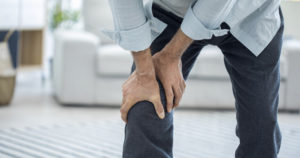
Of all the joints, our knees are arguably the ones most likely to feel pain. Lots of injuries can cause knee pain. Car accidents fall and sports accidents are some of the most common causes of knee injuries, like fractures, torn ligaments, and sprains. Even though it’s never fun to experience knee pain, when it follows an injury, at least you have a pretty good idea of what’s causing your discomfort. And that can make it a little easier to seek and receive proper treatment.
Sometimes though, knee pain occurs without a preceding injury. In those cases, it can be tempting to ignore the pain at first to see if it subsides on its own. The problem is, even though you might not have had an accident, the issue causing your pain can still be serious. And delaying care can wind up prolonging your symptoms and even making them worse.
Knee Pain Causes and Treatments
Most knee pain that’s not related to a direct injury involves the connective tissues (ligaments and tendons) or cartilage.
Knee tendonitis
Tendons connect the muscles of your leg and knee to the bones that form the joint. Tendonitis occurs when a tendon becomes irritated and inflamed. Typically, tendonitis is caused by straining your joint and your muscles, either through repetitive use, overuse, or overloading. If you spend a day doing an activity you’re not used to, like strenuous hiking or lots of bending and lifting, you can develop tendonitis. And you can also develop sore tendons from everyday activities, especially as you get older.
Bursitis
Bursae are small, fluid-filled sacs that prevent friction in joints. In the knee, the bursae help the tendons and ligaments glide smoothly over the bones in the joint. Bursitis occurs when these tiny sacs get inflamed and irritated. Overuse and repetitive use of your knee are typically the most common causes of bursitis.
Knee Pain Caused by Arthritis
Arthritis is a condition that affects the cartilage inside joints. Cartilage provides a thick, slick layer of protection that enables the bones inside a joint to glide smoothly, without sticking or painful friction. When the cartilage wears away or breaks down, the friction inside the joint increases, causing pain, stiffness and inflammation. Although there are several types of arthritis, osteoarthritis is by far the most common, caused by wear and tear and age-related changes. Arthritis usually develops where the thigh bone and shin bone meet, or between the thigh bone and the kneecap. Other types of arthritis include:
- Rheumatoid arthritis, an autoimmune disease
- Gout, caused by a buildup of uric acid crystals in the joint
- Pseudogout, is a buildup of calcium crystals in the joint fluid
- Septic arthritis, caused by an infection inside the knee joint
Infection
In addition to septic arthritis, other infections can also cause knee pain. Most infections also cause warmth and tenderness in the joint, and it’s not uncommon to have a fever as well.
Iliotibial band syndrome
Your iliotibial band is a strong band of tissue that extends from your hip to your knee. The band keeps your knee stable, and it also supports normal leg movements. Iliotibial band syndrome develops when the band gets irritated and inflamed. Knee pain occurs when the band rubs against the outer edge of your thigh bone. Like tendonitis, iliotibial band syndrome usually is associated with overuse or repetitive use of your legs.
Hip, foot or ankle problems
If you have a foot, hip or ankle injury, you might wind up putting more weight on the other side of your body. Over time, the change in your gait and balance can strain your knees.
Past Injuries
You might think that old injury has long since healed. But sometimes, even a forgotten injury can leave your knee weak or vulnerable to pain in the future. If an injury dislodges a tiny piece of bone or cartilage, you might not know it until months or years later, when that fragment interferes with the way your joint moves. Old kneecap injury? New knee pain might be a sign of kneecap instability. Likewise, other past injuries that weakened your tendons or ligaments might be to blame for current symptoms.
Cancer and Knee Pain
Although it’s uncommon, some types of cancer can also cause knee pain. Osteosarcoma is a type of bone cancer that’s associated with pain and swelling in the knee and leg. Symptoms tend to be worse with movement and weight-bearing activities. Some people with osteosarcoma find their pain is worse at night.
When to See the Doctor About your Knee Pain
Sure, it’s tempting to use an online “knee pain symptom checker” to try to figure out what’s causing your pain. The problem is, because joints are complex, knee pain self-diagnosis is very difficult. Like all your joints, your knees are “designed” to function without pain or stiffness. No amount of pain or stiffness is “normal.”
If you notice any type of discomfort in or around your knee joint, it’s always a good idea to schedule an office visit with Dr. Van Thiel.
As a leading orthopedic surgeon in Rockford and Crystal Lake, Dr. Van Thiel uses advanced diagnostic methods to make sure you receive the best, most appropriate care for meaningful pain relief. To find out what’s causing your knee pain, call OrthoIllinois at or schedule an appointment online today.
Dr. Van Thiel treats patients from all over Wisconsin and Illinois including Rockford, Elgin, Huntley, Dekalb, Crystal Lake, Barrington, McHenry, and Beloit.




